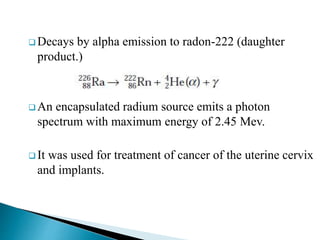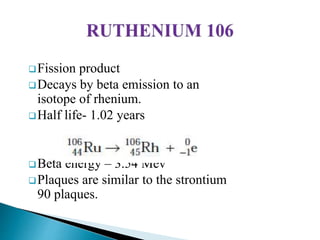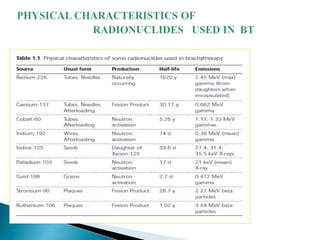Radioactive sources
- 1. Dr Kiran Kumar BR
- 2. In nature there are nearly 300 nuclei, consisting of different elements and their isotopes. Isotopes are nuclei having the same number of protons but different number of neutrons. Radioactivity is the release of energy and matter that results from changes in the nucleus of an atom.
- 3. Radioisotopes: A version of a chemical element that has an unstable nucleus and emits radiation during its decay to a stable form.
- 4. Radioisotopes come from: Nature, such as radon in the air or radium in the soil. Nuclear reactors by bombarding atoms with high-energy neutrons.
- 5. Three predominant types of radiation are emitted by radioisotopes: 1. alpha particles (+) 2. beta particles (-) 3. gamma rays. The different types of radiation have different penetration powers.
- 6. Rapidly dividing cells are particularly sensitive to damage by radiation. For this reason, some cancerous growths can be controlled or eliminated by irradiating the area containing the growth. Internal radionuclide therapy is by administering or planting a small radiation source, usually a gamma or beta emitter, in the target area. Short-range radiotherapy is known as brachytherapy. BRACHYTHERAPY
- 7. External irradiation (sometimes called teletherapy) Teletherapy is the use of radioactive material for production of external beam of gamma rays for Rx at a distance from the radioactive source(tele means “at a distance”) Teletherapy can be carried out using a gamma beam from a radioactive cobalt-60 source. TELETHERAPY
- 8. High specific activity Adequate photon energy Appropriate half-life Easy to make (or activate) Easy to handle Reasonable cost
- 9. Brachytherapy (BT) (brachy is Greek for “short distance”) consists of placing sealed radioactive sources very close to or in contact with the target tissue. The main advantage of brachytherapy technique is it delivers localized high dose to the tumor volume.
- 10. Ra-226: 0.975 Ci/g Ir-192: 9220 Ci/g An Ir-192 source can have much higher activity than a Ra-226 source for a given mass or size. This is one of reasons that Ir-192 is used as HDR source (about 10 Ci).
- 11. RADIUM 226 It is a part of the radioactive series. Starting with uranium-238 and ending with the stable isotope lead- 210. Half life – 1620 years
- 14. Decays by alpha emission to radon-222 (daughter product.) An encapsulated radium source emits a photon spectrum with maximum energy of 2.45 Mev. It was used for treatment of cancer of the uterine cervix and implants.
- 15.
- 16. Product of uranium-238 fission. Decays by β minus emission. Half life – 30.17 years Emits a photon energy 0.662 Mev.
- 18. Its lower photon energy eased the radiation protection requirements. Its solid physical form and lack of alpha emission made it safer in the tube being damaged. So caesium considered as safer than radium.
- 20. Spherical caesium 137 source as used in afterloading machine
- 21. Produced by neutron activation of the stable cobalt-59. Short half life – 5.26 years Decay by β minus emission. It emits gamma energies of 1.17 and 1.33 Mev. High specific activity More expensive than caesium.
- 23. Produced by the neutron activation of iridium-191. Half life- 74 days. Decays by beta emission. This emits a complex photon spectrum with maximum energy of 0.38 Mev. Its used in the form of a wire, used for low dose rate (LDR) manual implants.
- 25. Diagramatic representation of iridium 192 wire
- 29. The central radioactive core is an iridium / platinum alloy. Its surrounded by a 0.1mm thick platinum sheath. It is available in 0.3 mm or 0.6 mm overall diameter as wires or pins. Thin wire is coiled as 500 mm length. High specific activity. Its used for high dose rate afterloading machines.
- 31. Daughter product of xenon 125. Produced by the neutron activation of xenon 124. Iodine 125 decays electron capture. Half life - 59.6 days Gamma ray has an energy of 35.5 Kev.
- 32. Emits characteristic radiation of 27.4 and 31.4 Kev. This low energy gives a half value thickness of lead of 0.025 mm, which makes radiation shielding highly effective. Iodine 125 is incorporated with implantable seeds. Several types of seeds are available from different manufacturers.
- 33. TWO TYPES OF IODINE 125 SEEDS DIAGRAMMATIC REPRESENTATION OF FOR EXAMPLE
- 34. Figure shows the structure of Oncura type of 6702 and 6711 seeds. 6702 has the iodine 125 absorbed on to an ion exchange resin. It contains no radiographic marker. Its used for temporary implants. 6711 has iodine 125 adsorbed on to a silver rod. Silver acts as radiographic marker for imaging. Its used or prostate implants. Size of both seeds – 4.5 mm long and 0.8 mm diameter.
- 35. Produced by the neutron activation of the stable palladium 102 and the interaction of protons or deuterons on rhenium 103. It decays by electron capture. Half life – 17 days
- 36. Emits a mixture of gamma rays and characteristic radiaton. Its with a slightly lower mean energy of about 21 kev. It is encapsulated into seeds. Used for prostate implantation.
- 37. Produced by the neutron activation of the stable gold 197. Decays by beta emission to an isotope of mercury. Half life – 2.7 days
- 38. It emits a 0.412 Mev gamma photon. It is encapsulated in platinum. Used for permanent implantation, especially head and neck region.
- 39. It is a fission product. Used in brachytherapy as a beta emitter for superficial treatements. Decays by beta minus emission to yttrium 90. Half life – 28.7 years.
- 40. Beta energy is too small ( 546 kev ). Daughter element yttrium 90 (half life - 64 hours) also decay by beta minus emission. Beta energy – 2.27 Mev This material has been used for surface applicators – ophthalmic applicator.
- 41. Beta particles provide the required surface dose with rapid fall- off beneath. They were made from a strontium compound. It incorporated into a silver sheet. Then formed into an applicator with shielding on the reverse side. Several shapes and sizes are currently available.
- 42. Fission product Decays by beta emission to an isotope of rhenium. Half life- 1.02 years Beta energy – 3.54 Mev Plaques are similar to the strontium 90 plaques.
- 43. Active material is incorporated into a silver sheet forming the surface of the plaque. Plaque is provided with suture holes to allow it to be fixed. Several shapes and sizes are currently available.
- 45. Various other radionuclides have been used in brachytherapy. Californium 252 Phosphorous 32 Samarium 145 Tantalum 182
- 46. Artificial radionuclides are used. The source is in direct contact with a tissue or is sealed in an envelope. OPEN SOURCE 1. Can be applied metabolic way. Therapy of thyroid gland by radioactive iodine 131, which is selective captured by the thyroid. 2. Infiltration of the tumour by the radionuclides solution of a postrate tumour by the colloid gold Au-198. This way of application is seldom used today as well.
- 47. CLOSED SOURCES 1. Needles with a small amount of radioactive substance. They usually contain Co-60 or Cs- 137 . The needles are applied interstitially. 2. Sources are also inserted in to the body cavities 3. Large irradiation devices for teletherapy. The radionuclides is enclosed in a shielded container. The radioactive material is moved in to working position during irradiation. The most commonly used are Co-60 or Cs-137.















































